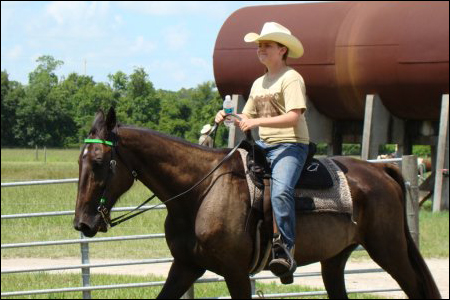- Return to Article Of The Month index
Running Rampant in the Summer Time
Summer is a fantastic time in the horse world. Longer days allow for extra time in the barn and warmer weather often makes riding more enjoyable. While summer can be a great time to catch up on those lost hours of riding, it's important not to overlook health precautions for you and your horse. One health concern that should not be ignored is Hydrophobia, more commonly known as Rabies.

According to the Florida Department of Agriculture the incidence of animal bites and positive rabies cases are typically highest in the summer months, with the highest number of positive cases typically occurring in August for Florida and the rest of the United States. Approximate figures for rabies cases in Florida through June 30, 2008 are 64 positive animals compared with 71 positives at the same time last year.
Animals are tested for rabies only if a suspect animal has exposed a person or domestic animal. As a result many animals suspected to be rabid are not tested and the number of true rabies cases in Florida is not known. As horses and riders spend more time outdoors, they may experience in-creased contact with wild and domestic animals. This makes it important for horse owners to understand how Rabies spreads and know what to do if you or your horse is at risk for exposure.
What is Rabies?
Rabies is a virus that attacks the central nervous system of mammals. It causes encephalitis or inflammation of brain and/or neurological tissue and can affect animals in several ways. Rabies is nearly al-ways fatal after symptoms begin.
How is the Rabies virus transmitted?
Rabies is transmitted through the saliva of an infected animal. This usually occurs through biting or licking of an open wound, but can include contact of saliva with mucous membranes. Raccoons, skunks, foxes, and bats are the wildlife most likely to carry rabies in the United States. Cats, cattle, and dogs are the domestic animals most likely to carry the disease.
What are the warning signs of Rabies?
A rabid horse or other animal may exhibit the following symptoms:
- Abnormal aggression Exaggerated movement
- Lack of coordination Failure to eat or drink
- Change in habits Blindness
- Fever Colic
- Depression Urinary incontinence
- Confused appearance and disorientation
- Excessive salivation, frothing at the mouth
- Lameness in one foot or leg, progressing to paralysis and convulsions
Additionally, rabid wildlife may exhibit the following symptoms:
- Nocturnal animals active during the day
- Odd vocalizations, chattering, shrill screams
- Unusual friendliness
What should I do if I believe my horse has been exposed to Rabies?
The only way to diagnose Rabies in an animal is post-mortem brain tissue tests. If you believe your horse has had an exposure to a presumed rabid animal, you should take the following steps:
- Isolate the horse for observation and contact your veterinarian.
- Isolate the presumed rabid animal, only if you can safely do so.
- Contact animal control officials so that they can quickly restrain and test the rabid animal.
Follow their instructions. This may include isolating your horse for observation, or putting the animal down.
What should I do if I have been exposed?
- Wash the bite or exposed area thoroughly with soap and water.
- Isolate the presumed rabid animal, only if you can safely do so.
- Contact animal control officials so that they can quickly restrain and test the rabid animal.
If you cannot isolate the animal, assume it is rabid and seek medical attention. Follow their instructions. If the animal is confirmed rabid, you must seek medical attention for Post-exposure Rabies vaccine.
Isn't human Rabies vaccination a series of painful shots in the stomach?
NO! Post-exposure Rabies treatment is now administered as injections to the arm. Few side effects have been observed and treatment is no more traumatic than a routine vaccination!
Sources
- Penn State University, The Equine Envelope, Volume 3 Issue 2
- Florida Department of Agriculture, Division of Animal Industry, Animal Health Bulletin, Summer 2008

